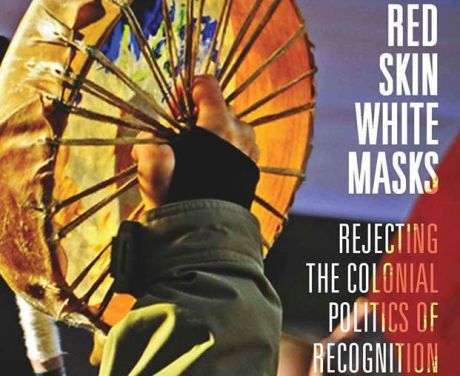Arts
You are here
For Indigenous nations to live, capitalism must die

July 27, 2015
Twenty-five years since resistance at Kanesatake, and in the midst of Truth and Reconciliation recommendations and the ongoing Idle No More movement, Glen Sean Coulthard’s book is a must read.
Red Skin, White Masks: Rejecting the Colonial Politics of Recognition critiques the politics of recognition and reconciliation and charts an alternative. Coulthard critically engages Karl Marx and Frantz Fanon, surveys Indigenous struggles from his own Dene Nation to Idle No More, critiques liberal philosophers Charles Taylor and Seyla Benhabib, and contributes to resurgent Indigenous politics alongside Taiaiake Alfred and Leanne Simpson. All this is concentrated in less than 200 pages, in a clear style that makes it as accessible as a work of political theory can be.
From assimilation to recognition
The recent release of the Truth and Reconciliation Commission report has highlighted how recognition and reconciliation dominate the discussion of Indigenous politics. But as Coulthard explains, this new tactic by the Canadian state—a response to waves of Indigenous resistance—is meant to mask an old strategy.
The 1969 White Paper aimed to forcibly assimilate Indigenous peoples, but was defeated by the Red Power movement. Through Section 35(1), the 1982 Constitution recognized Aboriginal and treaty rights on paper but made little difference on the ground, and the resulting frustration culminated in the defeat of the Meech Lake accord and resistance at Kanesatake in 1990. In response the 1996 Royal Commission on Aboriginal Peoples made a series of recommendations that have since been ignored, and the Harper government “apologized” for residential schools while continuing to attack Indigenous rights—sparking Idle No More, the latest cycle of Indigenous struggle.
By reviewing this history Coulthard identifies the Canadian state’s tactical shift post-1969: “The expression of Indigenous anticolonial nationalism that emerged during this period forced colonial power to modify itself from a structure that was once primarily reinforced by policies, techniques, and ideologies explicitly oriented around the genocidal/assimilation double, to one that is now reproduced through a seemingly more conciliatory set of discourses and institutional practices that emphasize our recognition and accommodation. Regardless of this modification, however, the relationship between Indigenous peoples and the state has remained colonial to its foundation.”
Primitive accumulation
To reinforce his argument, Coulthard critically engages Marx in two ways. First he uses his theory of “primitive accumulation” to explain the twin processes of colonization (dispossession and proletarianization) while focusing on the experience of Indigenous communities: “Dispossession, not proletarianization, has been the dominant background structure shaping the character of the historical relationship between Indigenous peoples and the Canadian state. Just as importantly, I would also argue that dispossession continues to inform the dominant modes of Indigenous resistance and critique that this relationship has provoked.”
By stressing Indigenous peoples’ experience of dispossession, Coulthard shows that primitive accumulation is a process that is ongoing but not necessarily violent. This insight (developing and bringing up to date Rosa Luxemburg's observations in The Accumulation of Capital) challenges the economic reductionism that has dominated academic Marxism (picked up from Stalinism), and also questions the past four decades of land claims. As Coulthard notes, “the process of primitive accumulation has been at least in part facilitated by the very mechanism of recognition that we hoped might shield our land and communities from it: the negotiation of a land settlement.”
Coulthard also draws on Marx’s concept of “mode of production” to highlight the Indigenous understanding of culture. As well as debunking pseudo-Marxist claims that cultural demands are divisive or reactionary, the history of his own Dene Nation’s struggle for self-determination shows that it was capital’s drive to accumulate that de-coupled cultural demands from social, economic and political transformation: “This broad understanding of mode of production as a mode of life accurately reflects what constitutes ‘culture’ in the sense that the Dene deployed the term, and which our claims for cultural recognition sought to secure through the negotiation of a land claim…For the state, recognizing and accommodating ‘the cultural’ through the negotiation of land claims would not involve the recognition of alternative Indigenous economies and forms of political authority, as the mode of production/mode of life concept suggests; instead, the state insisted that any institutionalized accommodation of Indigenous cultural difference be reconcilable with one political formation—namely, colonial sovereignty—and one mode of production—namely capitalism.”
Reconciliation vs resistance
Whereas truth and reconciliation initiatives historically emerged from countries that went through a formal transition—like Apartheid to liberal democracy in South Africa—no such transition has taken place in Canada. As Coulthard explains, exercises in “reconciliation” in the Canadian context serve to ideologically manufacture a transition: characterizing residential schools as “sad events” firmly in the past, rather than part of an ongoing process of colonization. As a result Indigenous people become the object of repair rather than the colonial relationship.
This pacifying discourse attempts to discipline Indigenous resistance by labeling anger and resentment as negative emotions about “the past” instead of critical consciousness in the present. Placing the Royal Commission on Aboriginal People’s in context, Coulthard shows how the state uses “reconciliation” as a tactic to blunt Indigenous resistance: “A decade of heightened First Nations militancy that culminated in the resistance at Kanesatake created the political and cultural context that RCAP’s call for recognition and reconciliation sought to mitigate—namely, the simmering anger and resentment of the colonized transformed into a resurgent affirmation of Indigenous difference that threatened to disrupt settler-colonialism’s sovereign claim over Indigenous peoples and our lands. In light of this, to suggest that we replace these emotions by a more conciliatory and constructive attitude like ‘forgiveness’ seems misplaced to me.”
Whereas the Canadian philosopher Charles Taylor calls on liberal states to bestow recognition on oppressed groups, Coulthard draws on Fanon to show how this is inherently colonial: it not only validates the colonial state and maintains its asymmetric power over Indigenous nations, but it also promotes internalized colonization—encouraging Indigenous peoples to identify more with the state than their own nations and traditions. As Coulthard warns, “The dominance of the legal approach to self-determination has over time helped produce a class of Aboriginal ‘citizens’ whose rights and identities have become defined more in relation to the colonial state and its legal apparatus than the history and traditions of Indigenous nations themselves. Similarly, strategies that have sought independence via capitalist economic development have already facilitated the creation of an emergent Aboriginal bourgeoisie whose thirst for profit has come to outweigh their ancestral obligations to the land and to others.” As a consequence, land claims that were once informed by an understanding of land as a system of reciprocal relations (which he terms “grounded normativity”) have become instead focused on land as a material resource from which to profit.
Coulthard also challenges liberal strategies to police oppressed communities. Whereas Turkish-American philosopher Seyla Benhabib looks to the state to defend women’s rights within cultural communities, Coulthard explains how this approach reinforces the racist assumption that Indigenous nations are incapable of self-determination and ignores the sexist interventions of the state into these nations. Exposing the sexist provisions of the Indian Act Coulthard shows that the state is not gender neutral—and that a defense of Indigenous culture and tradition needs to challenge the sexism the Canadian state has tried to inject into it.
Indigenous resurgence and Indigenous Marxism
Coulthard concludes with a call for cultural self-affirmation and Indigenous resurgence, critically assessing Fanon’s writings on the role of self-recognition in anti-colonial struggles and connecting them to contemporary Indigenous scholars—Mohawk political scientist Taiaiake Alfred and Anishinaabe feminist Leanne Simpson. After reviewing the emergence of Idle No More, which has exposed the failure of the tactic of recognition and reconciliation, Coulthard concludes with five theses on Indigenous resurgence and decolonization.
He defends direct action not only for its immediate effect—blocking the state from entering, and capital from leaving Indigenous communities—but also as a method to loosen internalized colonialism and prefigure a renewed relationship between Indigenous peoples and their land. He exposes gentrification as a new wave of dispossession of urban Indigenous populations, and stresses gender justice within decolonization. And he calls for moving beyond capitalism and the nation state, along with an openness to non-Indigenous allies, warning that “without such a massive transformation in the political economy of contemporary settler-colonialism, any efforts to rebuild our nations will remain parasitic on capitalism, and thus on the perpetual exploitation of our lands and labor.”
Red Skin, White Masks brings to mind the writings of Indigenous Marxist Howard Adams, a leading activist and theorist of the Red Power movement. His writings (Prison of Grass: Canada from a Native Point of View, and Tortured People: The Politics of Colonization) exposed Canada's long history of colonial dispossession, internalized colonization and co-optation, and the way capitalism uses racism to increase the exploitation of Indigenous workers and divide the working class. Contrary to the academic Marxists and left-materialists Coulthard challenges for subordinating anti-oppression and national liberation struggles to economics, Adams pointed to the potential of intertwining Indigenous radical nationalism with a class struggle against capitalism—from the “Riel rebellion” to the Red Power movement.
Faced with an economic and ecological crisis that disproportionately affect Indigenous communities—and a rising climate justice movement led by those communities and with increasing support from the labour movement—these ideas continue to resonate. As part of this latest wave of resistance, Coulthard has made an important contribution to Indigenous resurgence and contemporary Marxism, whose intertwining is critical for our time.
As he concludes: “It is time for our communities to seize the unique political opportunities of the day. In the delicate balance of having to ensure that his social conservative contempt for First Nations does not overwhelm his neoconservative love of the market, Prime Minister Harper has erred by letting the racism and sexism of the former outstrip his belligerent commitment to the latter. This is a novice mistake that Liberals like Jean Chretien and Paul Martin learned how to manage decades ago. As a result, the federal government has invigorated a struggle for Indigenous self-determination that must challenge the relationship between settler colonization and free-market fundamentalism in ways that refuse to be coopted by scraps of recognition, opportunistic apologies, and the cheap gift of political and economic inclusion. For Indigenous nations to live, capitalism must die. And for capitalism to die, we must actively participate in the construction of Indigenous alternatives to it.”
Follow Glen Coulthard @denerevenge, and get a copy of his book from the University of Minnesota Press or from your local bookstore
Section:










